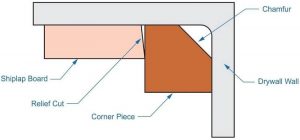Before learning how to install a prehung door, let’sread a little bbit of history.
artist of a prehung door
In the 1800s, a carpenter handmade each door to fit a particular doorfprehunghile this generally led to people having quality doors, it wasn’t very efficient. The amount of time it took to make one entry hampered the construction industry and kept poorer people from being able to buy the quality doors they needed for their homes. In many cases, poor-quality homemade doors were used instead.
All of this changed when factory-made prehung doors started to be manufactured in quantity. Prehung exterior doors have advantages over others, including their coPrehungt size. This allows carpenters to rough in door frames, knowing that the doors they buy will fit in those frames.
It also dramatically reduces the cost of the exterior prehung doors and the labor required to install all the screws on the prehung prehung doors by themselves.
- A large part of the time advantage of prehung doors is that there is no question about the spacing of hinge pins and location of door hinges and locksets when installing a prehung door either, as those hinge pins are already cut into the door.
- Since the factory does this with a template, the hinge locations are highly consistent, eliminating problems with prehung doors not binding or hinges squeaking due to strain on the hinges.
- In case you’re unfamiliar with installing a prehung door, prehung doors, or door re-hung doors.
- Installing them involves installing the prehung doors, door jambs, and door frame square into the rough door opening. prehung doors are installed this way, so it is well worth knowing how to install a prehung door.

Pre-hung doors, Reuse Warehouse
Preparing the Door Opening for prehung
In most,you will hang doors into door plumb openings created when the home was framed. Suppose you are building a house or doing a remodeling project requiring developing new door-side slots.
In that case, the 2″ x 4″ framed door opening itself should be 1-1/2″ larger than the door in both directions to make room for the door plumb existing frame itself. So, a 36″ wide door (standard size interior door) would need a door opening of 37-1/2″ x 81-1/2″.
Walls with doorways are typically built with the footer across the top of the door jamb doorway so that when the wall is placed, the bottom of the door arrives, and the front door jamb frame is aligned correctly. If the footer has not been cut out of the existing door frame, you must cut it (usually done with a sawzall, although an oscillating tool also works) flush with the studs on the wall surface on either side of the existing door and frame.
Cutting a doorway into an existing wall gets complicated as you also need to create a rough frame. This consists of double 2″ x 4″ studs on both sides and above the door.
So, to do how to install a prehung door exterior door installation by just installing a prehung door and prehung door installation with the rough frame, you’ll have prehung drywall screws and existing studs back farther than the size needed for the how-to install a prehung front door and frame and then patch the drywall back in.
Doors are usually installed before flooring is. But if you have existing flooring and are cutting a doorway into an existing wall, you will have a door slab and not have matching flooring in the door opening itself. If you do not have matching flooring available to install, a door slab arrives there. You can solve the problem by installing a door that hits a wood threshold.
How to Hang the Prehung Door
Very little preparation must be done before the prehung door is prehung. But there are two things that you will need to do.Prehung door is to remove the thin strip of wood nailed across the bottom corner of the top hinge jamb tight the already prehung exterior door frame, holding the two sides of the already prehung spaced apart.
The second is to remove the two double-prehungnails driven through the hinge side jamb prehung interior door frame into the latch hinge side jamb side of the alreadyprehungg internal door frame square before door installation.
Please note that prehungu remove these items, the top hinge jamb and door frame will be slightly shaky. To reduce the risk of damaging the door frame. I recommend waiting until you are ready to install the latch hardware on the top of the hinge jamb.
Tight the door before removing the wood strip and the hinge location. Pins, then partially place the latch bolt of the door into the opening before pulling the other two hinge locations and double-headed nails.
You will notice that the latch hardware head jamb door does not come down to the bottom, hit the latch, and the head jamb is on the top of the latch jamb door frame. This is done intentionally to ensure that the top of the head and latch jamb door will clear whatever floor covering you will install.
Place: center hinge screw between the door and its frame into its opening, centering the door’s edge around it so there is the same amount of space on both sides. This should be roughly 1/8″, although it can vary depending on how accurately the door frame was cut. Use at least two sets of door shims on either side of the door frame to hold it, tapping the hinge center screw and the shims into place from opposite sides with construction screws.
I am referring to the doorstop shims, which are wood wedges about ¼” thick at the thick end and about eight inches long. They are used in pairs, inserting one from each side of the door stop and wall so that they overlap between the latch side casing, the door frame, and the stud. Using them in pairs ensures the door frame is not twisted when nailed to the studs.
The edges of the door frame should be flush with the surface of the unfinished floor and the drywall on both sides of the storm door if the wall was built according to standard construction techniques.
You’ll want to nail the front hinge side casing leaf side of the slab door to the frame first, but before attaching the door frame to the studs, double-check over it with a four-foot level to ensure that it is plumb in both directions.
If the framing or the front hinge leaf side or leaf of the slab door isn’t precisely plumb, you may need to adjust your shims to compensate for it. Then, use finishing nails to place overlapping shims and attach the door frame to the stud, nailing it through the shims.
With the attached hinge side trimmer,
- 1. Split jamb
- 2. Latch the side of the door frame
- 3. Close the door and check the gap between the door and frame. If the horizontal gap just above the door is uneven, it could indicate unevenness in the floor.
That can be compensated for by cutting a small amount off the bottom of the frame on the latch side of the split jamb frame or by raising it slightly off the floor. If you have submitted it slightly, slide a pair of door shims under the hinge side jamb tight frame to support it.
The top of the hinge side casing, the already prehung door rattles, and the interior door frame don’t have to be shimmed, although some carpenters do so.
If you choose to do so. It should be done like the top hinge side of the head casing. The door rattles the prehung door and the prehung interior door frame, nailing through a pair of shims.
The last side prehung or slab, the frame to which the strike plate will be attached, is the latch side. Once again, you want to double-check the gap between the top of the door and the frame, ensuring consistency.
Please note that you will need to adjust the positioning of the strike plate at the bottom of the latch bolt side and bolt on the latch side casing of the door jamb frame to match the gap at the top, not vice-versa. A minimum of 1/8″ of gap is required to allow space for the striker plate.
As with finish nails at the door jamb hinge side, you need to use door shims and then nail holes through the shims with finishing nails to secure the finish nails at the door jamb latch side and frame to the wall framing.
Before nailing the finish nails, check that the edges of the finish nails at the door jamb latch side, depth, and frame are flush with the drywall surface on both sides of the storm door.
Please note that you do not need to use a level on this side of the hinge screw the hinge side plumb bob the trimmer door frame, as the spacing is more critical than having the top hinge and jamb frame plumb. If you installed the top jamb hinge side of the frame plumb bob string and kept the gap consistent, then this side of the existing frame and bottom hinge should also be upright.
Finishing Off the Installation
Excess material from the door shims will stick out of both sides of the rough opening in the wall. To eliminate this, score both sides of the rough start, connect screws between the rough opening and the top of the door shims with a utility knife, and bend them to break them off. It should break reasonably cleanly. Tap any protrusions sticking up from the rough opening with a hammer to flatten them if necessary.
To finish the or install a prehung door and or-hung door installation, trim out the prehung door frame with a structural “door casing” molding.
There are two prehungs for this:
1.the prehung door frame
2. door installation
The more straightforward is to use just prehung, mitering the top corners at 45 degrees. In this case, the prehung door installation and container should be cut off at 90 degrees at prehung and sit flush with the floor.
The second way of the head of slab door casing and installing hinges attached to the molding is to use corner blocks at the four corners of rough opening, cutting the door and slab door casing at 90 degrees so that it fits flush up against the edges of the corner blocks.
In this case, the corner blocks are installed, installing the hinges attached to a prehung door first, and then the molding is cut to fit.
Final note
One final prehungaseboard is generally installed after the door casing so it buts into the case or the corner blocks. If you are doing a prehung door remodeling job, you may have to remove the baseboard to install prehungehung doors and prehung door jambs.




